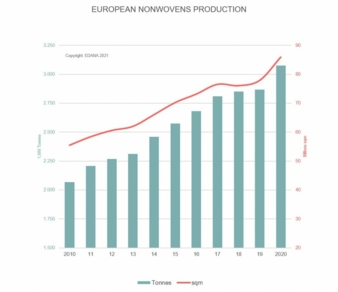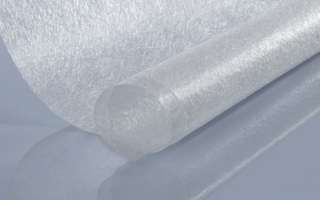24/05/2021 – Nonwovens — auf Deutsch lesen
Edana: Growth in nonwovens continues
European nonwoven production grows by over 7 percent to exceed 3 million tonnes in 2020.

According to figures collected and compiled by the Edana secretariat, production of nonwovens in Greater Europe grew by 7.2 percent in 2020 to reach 3,075,615 tonnes (and 85.9 billion square metres) with a total estimated turnover of 9,555 million euro. The total output of the 27 European Union countries is now over 2.15 million tonnes. © Edana
Edana, the leading global association serving the nonwovens and related industries, disclosed the results of its annual survey of European nonwovens production. Providing a comprehensive overview of the sector, the latest statistics demonstrate the industry’s drive and durability during a period of unprecedented change to demand drivers and supply chains.
According to figures collected and compiled by the Edana secretariat, production of nonwovens in Greater Europe grew by 7.2 percent in 2020 to reach 3,075,615 tonnes (and 85.9 billion square metres) with a total estimated turnover of 9,555 million euro. The total output of the 27 European Union countries is now over 2.15 million tonnes.
Jacques Prigneaux, Edana’s Market Analysis and Economic Affairs Director:
“The highest demand for materials intensively used to fight the pandemic impacted the production. Spunmelt and Drylaid-Hydroentangled nonwovens witnessed two-digit growth rates in both weight and surface area.” Thanks to the development in similar applications, the growth in the Wetlaid nonwovens was also substantial last year. Airlaid production, with opposite trends in different applications, recorded a flat situation compared to a year before.
“The main end-use for nonwovens remains the hygiene market with a 28 percent share of deliveries, amounting to 857,940 tonnes, a 9.6 percent growth in 2020. For obvious reasons, the most significant growth areas for nonwovens in 2020 were observed in medical (+118.0 percent) and wipes/personal wipes (+22.0 percent) followed by garments (+32.6 percent).”
In contrast, major declines were noticed in automotive interiors (down 23 percent), floor coverings, table linen and interlinings.
Additionally, several important durable sectors in terms of volumes sold, such as in construction markets and liquid filtration showed limited growth and, in the case of agricultural applications, negative growth.


